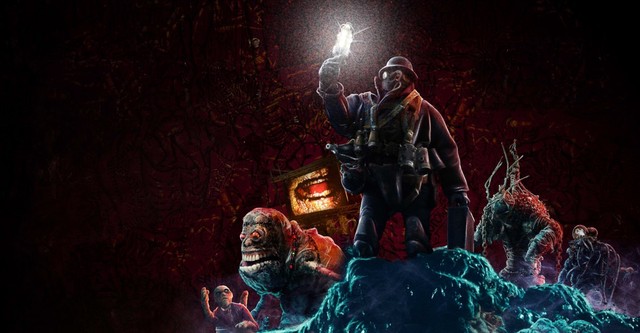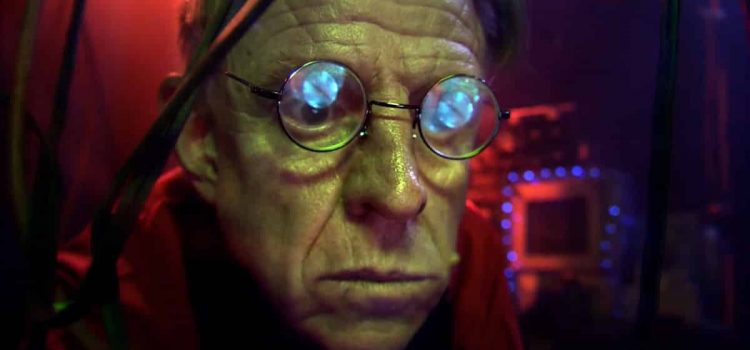By Alex McPherson
A Rube-Goldbergian smorgasbord of grotesqueries, special effects guru Phil Tippett’s stop-motion passion project, “Mad God,” oozes with both incredible artistry and dispiriting nihilism.
A curving tower stretches into the red-scorched sky, grasping for freedom from the hellscape below. A scroll reads “Leviticus 26-27,” in which God tells Moses the curses he’ll bring down upon the Israelites if they’re disobedient. We’re then introduced to a humanoid figure, clad in steampunk-esque attire and a gas mask, who boards a diving bell and floats beneath the clouds.
Referred to as “the Assassin,” he’s sent on a fateful mission by a long-nailed overseer (Alex Cox, portraying the titular Mad God in one of the film’s only live-action performances). As the Assassin descends, he passes remnants of civilizations gone by and monuments to higher powers, until finally reaching the cracked, muck-covered surface.
He carries a suitcase with a bomb inside, as well as a map that seemingly crumbles every time it’s glanced at. En route to an ambiguous destination, the Assassin navigates a hostile environment filled with untold horrors. This includes a cleaver-wielding troll with huge teeth, disposable workers molded from excrement slaving away to a scabbed-mouthed supervisor screeching in babytalk, and surgeons engaging in extreme medical malpractice (to say the least).
Indeed, Tippett’s painstakingly realized world is the real star of the show, and “Mad God” eventually shifts focus to showcase bloody vignettes within each circle of Hell, progressing closer towards the core of it all. Is there a light at the end of the tunnel?
Nope, but it’s damn-near impossible to avert your gaze from the darkness. “Mad God” is a work of such incredible devotion that the plot’s obliqueness doesn’t detract much from the experience on the whole — so long as viewers approach it as more of an artistic thesis statement on humanity than a traditional narrative.
Tippett’s film is, above all else, a display of one man’s staggering interpretation of a universe broken beyond repair, and each frame of this 30-years-in-the-making project is meticulously-formed — the gnarled beasts and industrial apocalypse surrounding them are lent tactility by the stop-motion approach. This renders them extra disturbing and, strangely enough, charming in a morbidly fascinating way, before they’re unceremoniously brutalized by their next-door neighbors.
The cinematography, by Tippett and Chris Morley, also rivals any live-action production released this year, with shots emphasizing the vast, imposing scale of a place stuck in endless cycles of war, exploitation, and utter hopelessness.
Minotaurs, spider-legged aliens, a baby resembling that of “Eraserhead,” a sentient doll wasting away, the camera exhibits them all, unflinching in its gaze, leaving immediate, searing impressions. Add to this a wistful score by Dan Wool — featuring a central melody gradually morphed over the course of the film — and “Mad God” is glorious to behold from a visual and auditory perspective.
Story-wise, it’s a bit more complicated. As viewers are shepherded from one deranged situation after another like tourists, “Mad God” reveals itself to ultimately be an illustration of humanity’s worst instincts and the futility of existence when all is out of your control; survival is tenuous at best. Everything in “Mad God” feeds into the next, like a clockwork machine of suffering, suiting the needs of forces beyond our comprehension, forever churning onwards even through civilization’s extinction.
The film eludes simple explanation, and “Mad God” stumbles as a result of the dour, sadistic tone maintained from beginning to end. Regardless of the relatively brief, 85-minute runtime, observing the same themes being repeating themselves again and again — albeit via different vessels — grows tiresome.
Additionally, we don’t spend enough time with any specific creatures to grow “attached” to them, which makes the appeal of “Mad God” centered around what unhinged sight Tippett has in store for us next. The most sympathetic entities, surprisingly, are those aforementioned shit-people, doomed to serve a tyrannical overlord without any agency of their own. It’s all a bit of a sensory overload, almost feeling overstuffed by the conclusion.
This relentlessness might just be the point, however, lending the film’s final psychedelic stretch a sense of existential release as we witness death and rebirth on a grand scale.
Perhaps the epitome of “isn’t for all tastes,” “Mad God” is a nevertheless impressive work of craftsmanship that intrigues and repels in equal measure.

“Mad God” is a 2021 animated fantasy-horror film written and directed by Phil Tippett. It stars Alex Cox and runs 1 hour, 23 minutes. It is is intended to be viewed by mature, adult audiences and is not suitable for children under 17. It is available on Shudder, AMC on Demand and Spectrum on Demand. Alex’s grade: B
Alex McPherson is an unabashed pop culture nerd and a member of the St. Louis Film Critics Association.

